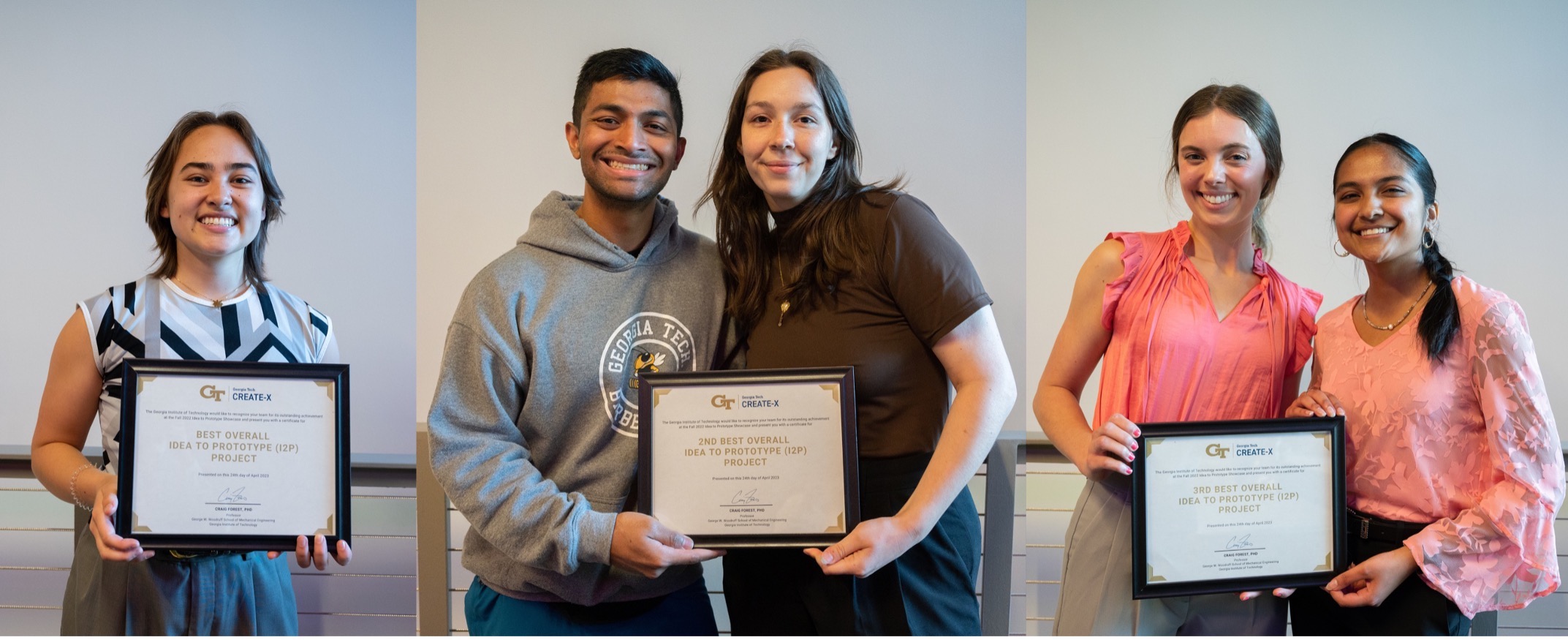
May 03, 2023
Crowds of people zigzagged up and down rows of booths set up in the Marcus Nanotechnology Building atrium to see what teams had to offer at last month’s Idea-to-Prototype (I2P) event. It was the culmination of the semester-long I2P course, which enables students to turn invention ideas into working products.
“I’m so excited,” said Mya Griesbaum, a first-year materials science and engineering student.
This was the second time Griesbaum had taken the I2P course and presented at the showcase. Griesbaum came back to see how other students had developed their projects, but also for I2P resources to develop her own, like research education, class credit, a $500 reimbursement for physical expenses, and faculty mentorship. The access to labs and mentors was particularly helpful, she said.
On her table, she had a spread of materials, including a halter top. Griesbaum created a fungi-derived alternative to leather, called Mycorrhiza, in collaboration with Pratyusha Akavaram, Irene Dumitriu, Ben Collins, and Aryaman Jha. Griesbaum worked two semesters on perfecting the leather, going through several lab mishaps and iterative research.
“Progress can be really slow, and patience is key,” she said. “I remember going in and really wanting to make a scalable product in a single semester and that definitely was not the case.”
However, Griesbaum encouraged other students to not be deterred.
“You don't have to know as much as you think you do. You do not have to be an expert in a field whatsoever. There are so many people who can help you out and who want to help you out and share the knowledge,” she said. “Just go for it.”
Who Wants a Cricket Brownie?
At another booth, an attendee with over a decade of experience in marketing alternative flowers and sustainable products offered support to Lauren Duderstadt, a fifth-year student and double major in mechanical engineering and industrial design, and Rohan Banerjee, another fifth-year student and mechanical engineer major, for their cricket powder-based snack, Crikey.
The pair had brought brownie samples made from pulverized crickets that boasted 20 grams of protein per serving. The samples had a chocolate taste but also a pillowy texture, something the team worked hard to achieve.
At first, the texture had been sandy. Trying to get the texture and taste right propelled them to continue, Banerjee said.
“On a granular, day-to-day level, when we’re working on a prototype, tasting it and seeing what we think, it’s that curiosity of ‘What if we tweak this? What if we can make it a little better?’” Banerjee said. “And over months of doing that, you end up with something dramatically better than where you started.”
During that iteration process, Banerjee appreciated the faculty resources most.
“Even though we picked something that’s seemingly niche, our mentor was someone we found to have significant experience in marketing and product development in similar spaces. He was able to give us a lot of really good feedback,” Banerjee said.
Craig Forest, associate director for CREATE-X’s MAKE program, said many students gain applicable skills and confidence working with CREATE-X mentors.
“Since 2015, more than 1,500 students have been able to pursue their invention ideas because of the generous time from mentors across campus and the resources of CREATE-X,” Forest said. “I2P gives students the resources, incentives, and structure to move their idea from their head to a real, working prototype on the table.”
Why Not Be the Change?
At another booth, a uterus model sat prominently on display. Sarah Deiters, a fourth-year biomedical engineering major, and Ayusha Prasad, a second-year biomedical engineering major, had created a product called Cervilove, designed to make IUD insertion less painful.
“There are many women who suffer with IUD insertion, and a lot of women who don't even attempt to use it because of the pain,” Deiters said. “So, attacking that idea has been awesome.”
Some attendees stopped by to hear about the product. The students explained that the current process for insertion uses a tenaculum, which pierces cervical tissue and was developed from forceps used in the 19th century for bullet extraction. Impressed attendees gave the team contacts for investors and additional support.
“IUD insertion hasn’t really changed since IUDs became popular nearly 75 years ago,” Deiters said. “I was just thinking, ‘Why can’t we do something about it? What’s keeping us from changing the culture and the whole insertion process for IUDs?’”
Prasad said the entire experience of I2P boosted their confidence.
“Knowing that somehow and some way we can potentially make a better healthcare environment for women is something that drives us forward,” Prasad said. “I think if you’re passionate about something, then this is definitely the place for it to take off.”
Spring 2023 I2P Showcase Winners
1st place: Mycorrhiza
(Mya Griesbaum (lead), and collaborators, Pratyusha Akavaram, Irene Dumitriu, Ben Collins, and Aryaman Jha)
2nd place: Crikey (Lauren Duderstadt and Rohan Banerjee)
3rd place: Cervilove (Sarah Deiters and Ayusha Prasad)
Mycorrhiza gained access to the CREATE-X summer startup accelerator, Georgia Tech Startup Launch, giving the startup $5,000 in optional seed funding, coaching, and free incorporation services. Mycorrhiza will also gain access to investors and industry partners at Demo Day, which attracts more than 1,3000 attendees, and more.
I2P applications for the summer and fall are open. Students must apply for the program to register for the course. The last deadline for the summer session is May 15. Read more about the course on the CREATE-X website.